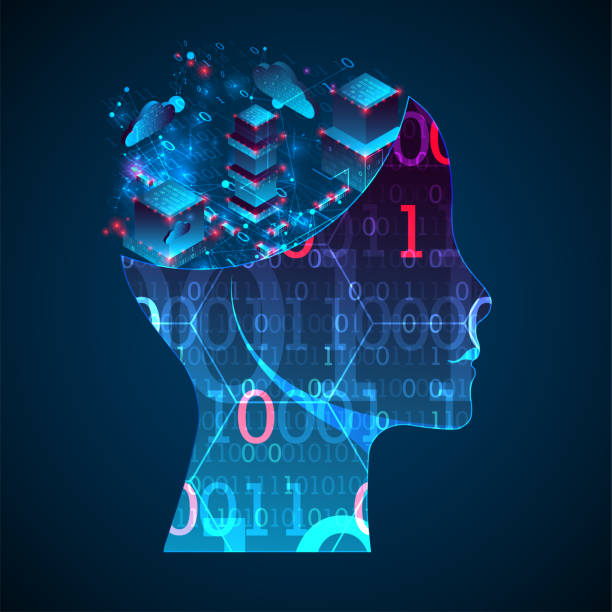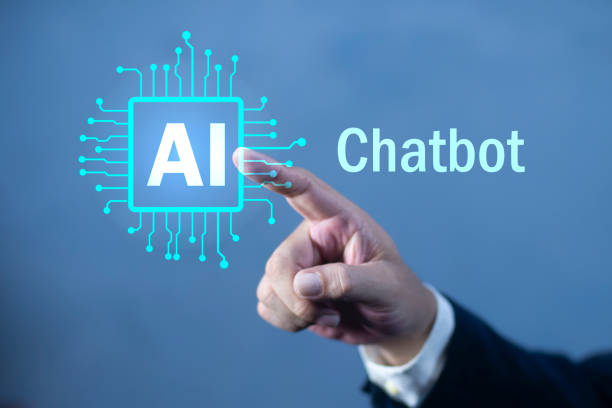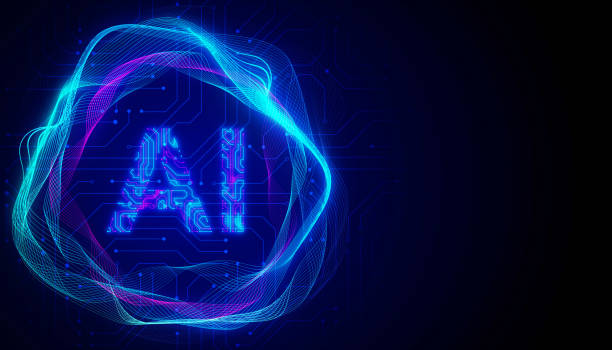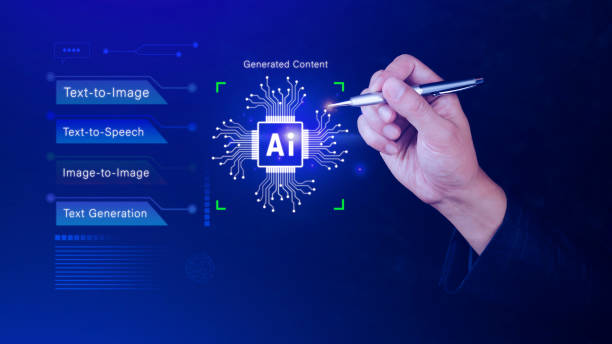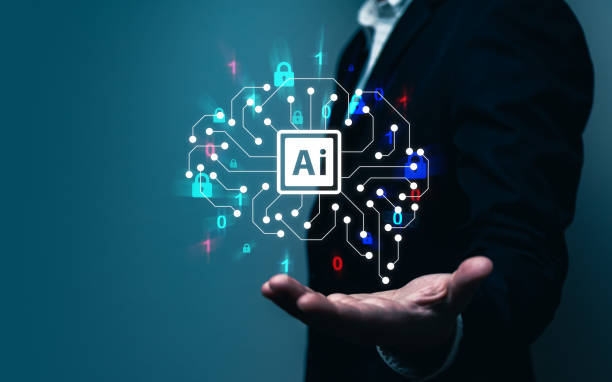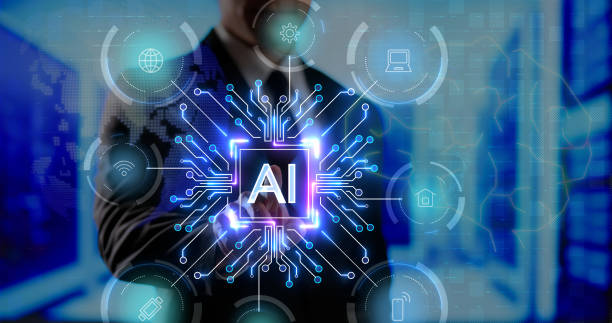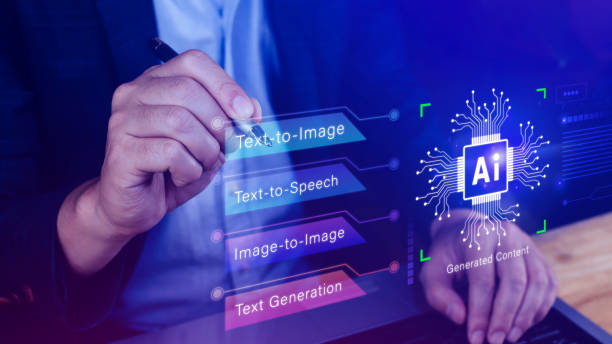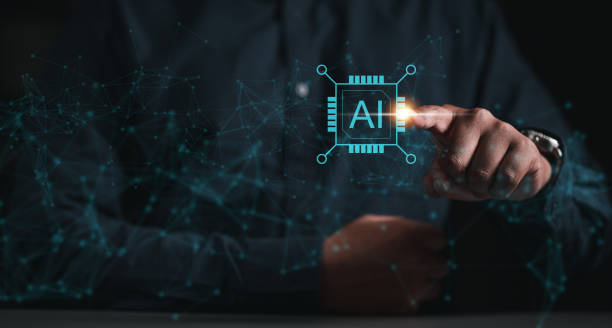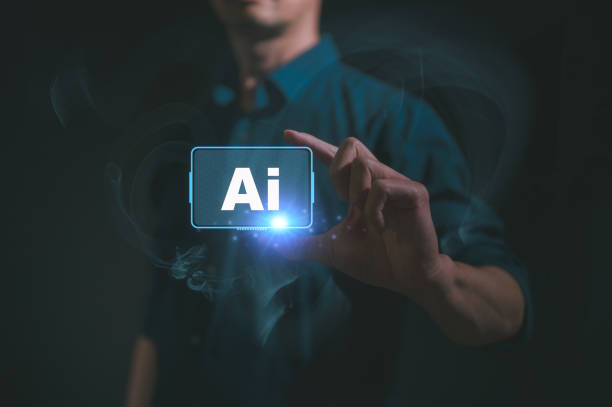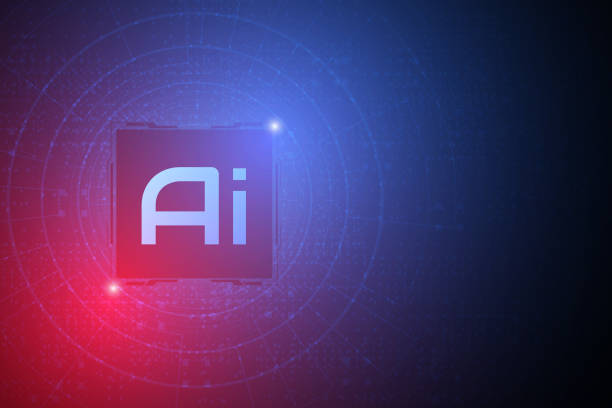Understanding the Concept of AI Robots and Their Applications
Today, #Artificial_Intelligence is rapidly advancing and plays an important role in our lives.
One of the fascinating aspects of this progress is the emergence of AI robots.
But what exactly is an AI robot? Simply put, an AI robot is a computer program that is capable of performing tasks that usually require human intelligence.
These tasks can include learning, reasoning, problem-solving, and understanding natural language.
AI robots have applications in various fields, including:
- Customer Support: Answering customer questions and providing guidance
- Healthcare: Helping to diagnose diseases and provide medical care
- Finance: Analyzing financial data and providing investment recommendations
- Education: Providing personalized education and helping with learning
This list is only a part of the wide range of applications of AI robots.
As technology advances, it is expected that these robots will play a more prominent role in our lives.
Does your company’s website create a professional and lasting first impression on potential customers? Rasaweb, with professional corporate website design, not only represents the credibility of your brand but also opens a path for your business growth.
✅ Create a powerful and reliable brand image
✅ Attract target customers and increase sales
⚡ Get a free consultation
Types of AI Robots: Examining Capabilities and Differences
AI robots come in different types, each with different capabilities and applications based on their architecture and algorithms.
In general, they can be divided into the following categories:
- Rule-Based Robots: These robots operate based on a set of pre-defined rules.
They are suitable for simple and repetitive tasks, but they struggle when faced with complex and unexpected situations. - Machine Learning Robots: These robots learn from data and can improve their performance over time.
They are very suitable for tasks that require data analysis and prediction.
AI robots based on machine learning are divided into two main categories: - Supervised Learning: The robot is trained using labeled data.
- Unsupervised Learning: The robot discovers patterns in unlabeled data.
- Natural Language Processing (NLP) Robots: These robots are capable of understanding and generating human language.
They are very useful for tasks such as machine translation, answering questions, and generating content. - Hybrid Robots: These robots use a combination of different types of AI to perform better.
For example, a hybrid robot may use machine learning to analyze data and natural language processing to communicate with users.
Click here to preview your posts with PRO themes ››
Choosing the right type of AI robot depends on the type of task and your specific needs.
Introducing AI Robot Building Tools: From Coding Platforms to APIs
To build an AI robot, various tools are available that you can use depending on your level of expertise and needs.
These tools can be divided into two general categories:
- Coding Platforms: These platforms allow you to develop your AI robot using programming languages such as Python, Java, and C++.
Some of the most popular coding platforms include: - TensorFlow: An open-source library for machine learning developed by Google.
- PyTorch: An open-source machine learning framework that is widely used in research.
- Keras: A high-level API for building neural networks that is compatible with TensorFlow and Theano.
- APIs (Application Programming Interfaces): These APIs allow you to use pre-built AI capabilities in your AI robot.
This method is very suitable for those who do not have in-depth programming knowledge.
Some of the most popular APIs include: - Google Cloud AI: A collection of APIs for natural language processing, computer vision, and machine learning.
- Microsoft Azure AI: A collection of APIs and services for building intelligent applications.
- IBM Watson: A collection of APIs and tools for developing AI applications.
Choosing the right tool depends on your level of expertise, project complexity, and budget.
| Tool | Type | Application | Required Expertise Level |
|---|---|---|---|
| TensorFlow | Coding Platform | Machine Learning | Expert |
| PyTorch | Coding Platform | Machine Learning | Expert |
| Keras | Coding Platform | Building Neural Networks | Intermediate |
| Google Cloud AI | API | Natural Language Processing, Computer Vision | Beginner |
| Microsoft Azure AI | API | Developing Intelligent Applications | Beginner |
| IBM Watson | API | Developing AI Applications | Beginner |
Steps to Build an AI Robot: Step by Step
Building an AI robot can be a complex process, but by following a series of specific steps, you can simplify this process.
Here is a step-by-step guide to building an AI robot:
- Define the Goal: First, you need to define your goal for building an AI robot.
What problem do you want to solve? What task do you want to automate? - Collect Data: To train your AI robot, you need data.
The type of data required depends on the type of task the AI robot will perform. - Select an Algorithm: There are different algorithms for machine learning.
You need to choose an algorithm that is suitable for your type of data and task. - Train the Model: Using the collected data and the selected algorithm, train your AI robot model.
- Evaluate the Model: After training the model, you need to evaluate it to make sure it is working correctly.
- Optimize the Model: If needed, optimize your model to improve its performance.
- Deploy the Model: After optimizing the model, deploy it in a real-world environment.
- Monitor and Maintain: Continuously monitor the performance of your AI robot and maintain it as needed.
These steps are a general guide and may need to be modified depending on your type of project.
Are you frustrated with the low conversion rate of your online store? Rasaweb turns your online store into a powerful tool for attracting and converting customers!
✅ Significantly increase the conversion rate from visitor to buyer
✅ Unparalleled user experience to increase customer satisfaction and loyalty⚡ Get a free consultation from Rasaweb!
Challenges Facing AI Robot Developers
The development of AI robots faces many challenges.
Some of these challenges include:
- Data Scarcity: A lot of data is needed to train an AI robot.
Collecting and labeling this data can be time-consuming and costly. - Data Quality: The quality of the training data directly affects the performance of the AI robot.
Poor quality data can lead to incorrect and unreliable results. - Algorithm Selection: Choosing the right algorithm for a specific task can be difficult.
- Interpretability: Understanding how an AI robot works can be difficult, especially if it uses complex algorithms.
- Ethical Issues: The use of AI robots can raise serious ethical issues, such as discrimination, privacy, and accountability.
Developers of AI robots must consider these challenges and try to find appropriate solutions for them.
The Future of AI Robots: Predictions and Trends
The future of AI robots looks very bright.
As technology advances, it is expected that these robots will play a more prominent role in our lives.
Some of the important trends in this field include:
- Task Automation: AI robots will be increasingly used to automate various tasks in different industries.
- Personalization: AI robots will be able to provide more personalized experiences for users.
- Human-Machine Collaboration: AI robots will increasingly collaborate with humans to increase productivity and efficiency.
- Expanding Applications: The applications of AI robots in various fields, including healthcare, education, finance, and transportation, will expand.
However, ethical and social issues related to AI robots must also be addressed, and the responsible development and use of this technology must be ensured.
Also, for developers and enthusiasts in this field, examine the ways to succeed in the AI career path.
The Impact of AI Robots on the Labor Market: Opportunities and Threats
The emergence of AI robots will have a significant impact on the labor market.
On the one hand, AI robots can lead to the automation of tasks and reduce the need for human labor in some industries.
This can lead to job losses and increased unemployment rates.
On the other hand, AI robots can also create new job opportunities.
For example, the need for AI specialists, data scientists, and software engineers who are capable of developing, deploying, and maintaining AI robots will increase.
In addition, AI robots can help increase productivity and economic growth, which can lead to the creation of new jobs in other industries.
In general, the impact of AI robots on the labor market is complex and depends on various factors.
To mitigate negative effects and take advantage of the opportunities created, appropriate policies in the fields of education, retraining, and labor support should be adopted.
| Opportunities | Threats |
|---|---|
| Creating New Jobs (AI Specialists, Data Scientists, Software Engineers) | Job Losses Due to Automation |
| Increasing Productivity and Economic Growth | Increased Unemployment Rates |
| Developing New Industries | Need for Retraining and Adapting to New Technologies |
| Improving Quality of Life | Creating Class Divisions |
Ethical Issues Surrounding AI Robots and Solutions to Address Them
The development and use of AI robots raises important ethical issues.
Some of these issues include:
- Discrimination: AI robots can make discriminatory decisions based on their training data.
- Privacy: The collection and use of personal data by AI robots can violate people’s privacy.
- Accountability: In the event of an error or damage caused by an AI robot, it is difficult to determine responsibility.
- Transparency: Understanding how an AI robot makes decisions can be difficult.
To address these ethical issues, appropriate solutions must be adopted.
Some of these solutions include:
- Developing Fair Algorithms: Algorithms that prevent discrimination.
- Protecting Privacy: Collecting and using personal data responsibly.
- Establishing Accountability: Establishing rules and regulations for accountability in the event of an error.
- Increasing Transparency: Striving to understand how an AI robot makes decisions.
Are you tired of your company’s website failing to meet your expectations? Design a professional website with Rasaweb that showcases the true face of your business.
✅ Increase the attraction of new customers and sales leads
✅ Increase the credibility and trust of your brand with your audience
⚡ Get a free website design consultation!
AI Robot Security: Threats and Protective Measures
The security of AI robots is an important issue that needs to be addressed.
AI robots can be vulnerable to cyberattacks, and hackers can exploit these vulnerabilities for malicious purposes.
Some common security threats include:
- Destructive Attacks: Hackers can disrupt the performance of the AI robot by manipulating the training data.
- Data Extraction Attacks: Hackers can use AI robots to extract sensitive information from systems.
- Denial-of-Service Attacks: Hackers can disable the AI robot by creating heavy traffic.
To protect AI robots from these threats, appropriate protective measures must be taken.
Some of these solutions include:
- Using Encryption: Encrypting data can prevent unauthorized access to sensitive information.
- Updating Software: Regularly updating software can fix security vulnerabilities.
- Using a Firewall: A firewall can prevent unauthorized access to the system.
- Monitoring the System: Continuously monitoring the system can help identify and prevent cyberattacks.
Learn More About AI Robots: Resources and References
If you are interested in learning more about AI robots, various resources and references are available.
Some of these resources include:
- Online Courses: There are numerous online courses in the field of artificial intelligence and machine learning that you can use to learn basic and advanced concepts.
Maktabkhooneh is one of the online learning sites in this field. - Books: Many books have been published in the field of artificial intelligence and machine learning that you can use to deepen your knowledge.
- Scientific Articles: Scientific articles published in reputable conferences and journals can introduce you to the latest achievements in artificial intelligence.
- Websites and Blogs: There are numerous websites and blogs in the field of artificial intelligence that you can use to receive new information and news.
- Online Forums and Groups: Online forums and groups can help you connect with other AI enthusiasts and learn from their experiences.
By using these resources and references, you can increase your knowledge of AI robots and become an expert in this field.
Frequently Asked Questions
| Question | Answer |
|---|---|
| What is an AI Robot? | An AI Robot is a machine capable of understanding the environment, reasoning, learning, and making decisions to perform tasks independently. |
| What is the difference between regular robots and AI robots? | Regular robots perform repetitive tasks based on pre-programming, while AI robots can learn from experience, interact dynamically with the environment, and even behave in a way that resembles human intelligence. |
| What are the main applications of AI robots? | They are used in industries (manufacturing, assembly), medicine (surgery, diagnosis), services (customer support, household), exploration (space, underwater), and many other fields. |
| What technologies are used in building AI robots? | Machine Learning, Computer Vision, Natural Language Processing, Deep Learning, and Robotics are among the key technologies. |
| Can AI robots have emotions? | Currently, robots do not have emotions in the human sense. They can identify and react to emotions, but they do not experience emotions themselves. |
| What are the main challenges in developing AI robots? | Safety, reliability, ethics, autonomy, adaptability to complex environments, and natural interaction with humans are important challenges. |
| How are AI robots trained? | They are usually trained using a large amount of data, machine learning algorithms, and deep learning to identify patterns and make decisions. |
| Examples of AI robots in everyday life? | Smart robotic vacuum cleaners, customer support chat robots, self-driving cars, and surgical robots in hospitals. |
| Are AI robots a threat to human jobs? | Some repetitive jobs may be automated, but at the same time, robots can increase productivity and create new jobs in the development, maintenance, and monitoring of these systems. |
| How is the future of AI robots predicted? | They are expected to become smarter, more autonomous, and capable of performing more complex tasks, and to interact more closely with humans in various environments. |
And other services of Rasa Web Advertising Agency in the field of advertising
Intelligent Sales Automation: A combination of creativity and technology to increase website traffic through intelligent data analysis.
Intelligent UI/UX: A creative platform to improve customer behavior analysis with attractive user interface design.
Intelligent Brand Identity: A creative platform to improve website traffic by managing Google Ads.
Intelligent Link Building: An effective tool for managing campaigns with a content-based SEO strategy.
Intelligent Sales Automation: A combination of creativity and technology to manage campaigns through attractive user interface design.
And more than a hundred other services in the field of internet advertising, advertising consulting, and organizational solutions
Internet Advertising | Advertising Strategy | Advertorial
Resources
Building a Telegram bot with GPT-3
,A glimpse of the applications of the GPT chat robot for content creation
,What is a smart chatbot? – Chat robot comparison
,Types of smart chatbots
? With Rasaweb Afarin, transform your business in the digital world. By providing comprehensive digital marketing services, including custom website design, we help you shine in today’s competitive market and achieve your goals.
📍 Tehran, Mirdamad Street, next to the Central Bank, Kazerun Jonoubi Alley, Ramin Alley No. 6
“`

